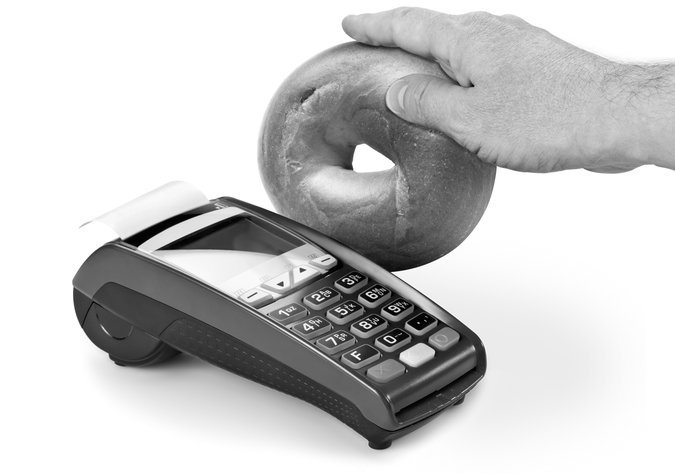
THIS week Apple announced two new pieces of hardware, the iPhone 6 and a “smartwatch.” But as flashy as they are, neither item is as groundbreaking as a piece of software that will accompany them: a digital wallet, allowing users to eschew cash and credit cards for a quick swipe of their device at the register.
Apple’s digital wallet, if widely adopted, could usher in a new era of ease and convenience. But the really exciting part is the fast-emerging future that it points toward, in which virtual assets of all sorts — traditional currencies, but also Bitcoin, airline miles, cellphone minutes — are interchangeable, opening up enormous purchasing power for consumers and creating tough challenges for governments around the world.
Moving toward a digital wallet for dollars (or yen, or euros) is only a marginal step forward; throughout history, money’s value has been largely virtual anyway — think of stocks, or personal lines of credit. The real change is how the digital wallet technology facilitates the parallel emergence of virtual purchasing power, like loyalty points.
We don’t typically think of these as currency, because virtual money has traditionally been locked down, in the sense that its use was strictly limited: If you earned points from Amazon, only you could use them, and you could exchange them for dollars only within the Amazon marketplace. Meanwhile, up to now, the only currencies you could use everywhere in an economy were state-issued currencies, like the dollar.
But that distinction is eroding: After all, the value of a currency lies in what you can buy with it, not in the fact that a government says it’s worth something. So if I want to buy a widget, and the only thing I can use to buy it is Widgetcash, then I am willing to trade dollars or euros or anything else for Widgetcash. When I buy something with Widgetcash, it doesn’t go through any bank.
That’s why a digital wallet, loaded with your dollars, credit and loyalty points, is such a revolutionary technology — it makes those transfers and transactions seamless and safe.
Imagine you want to buy a shirt at Target. Your digital wallet can pay for it with dollars, your Target points or any other form of purchasing power that Target accepts. Wave your phone at the cash register, and the shirt is yours.
That’s the sort of thing that the current generation of digital wallets already promises; the only obstacle is adoption by retailers. But that won’t be an obstacle for long. Frictionless exchange is a killer app. Some companies might lose value in their loyalty programs, but others will find enormous value in issuing their own currencies for advertising or data-tracking purposes, or even just because the creation of a successful virtual currency or digital wallet lets companies make money by making money. That’s certainly Apple’s bet.
The revolution is what comes next: an exchange that connects and trades these different stores of value to find the most cost-efficient one to use, both within your wallet and between wallet users, worldwide. Let’s say you want to buy an audiobook from Best Buy. It costs $16, or 1,000 My Best Buy points, or M.B.B.P.s. Your wallet contains several hundred dollars and 200 Best Buy points. The wallet software automatically determines that, at the current exchange rate between M.B.B.P.s and dollars, it is better to buy using the points.
But then let’s say you only have 50 M.B.B.P.s. The wallet system searches its clients and finds someone — call her Hannah — with enough M.B.B.P.s for the transaction. It buys the audiobook with her points and sends it to you, and sends Hannah dollars from your account.
Following Bitcoin’s protocol, the wallet software broadcasts these transactions to the network, and every wallet in the world updates the M.B.B.P.-to-dollar exchange rate.
The idea is that you can buy anything, with anything. The wallet will find the best deal and execute it. In so doing, it will ignore the historical and cultural differences between dollars, points, coins and virtual property. It’s all bits anyway.
This sort of digital wallet raises difficult problems for regulators, who rely on institutional intermediaries like banks as the point for monitoring transactions. But a digital wallet can be a phone app; just like the cash in your pocket, it doesn’t require accounts with any intermediary. A wallet app can be written by anyone, downloaded by anyone and secured and maintained by everyone. In this huge river of money, there is no narrow channel from which the state can divert flow into its own fields.
Consider the tax implications. If you get caught cheating on your taxes and flee the country, the government could compel your bank to freeze your assets and cough up the money. But what if there’s no bank?
One concern that doesn’t apply is transparency. Digital wallets don’t hide trades or encourage criminal transactions. Using Bitcoin is much less secret than using hard cash. The government, and anybody else, can easily see the trades passing through our wallets, just as every trade in Bitcoin is visible at blockchain.info. Even if you try to hide who you are, network or traffic analysis can often de-anonymize you. The critical point is that, with a digital wallet, a government or bank can see the trades, but it will be harder to compel or block them.
As exchange becomes less costly to perform, it becomes more costly to regulate. That means different things depending on your politics. You might celebrate the freedom the technology could bring to the 2.5 billion people in the world without adequate access to financial services, or you might worry about abuse by criminals. One thing that will not work is pretending that these technologies — and their revolutionary implications — don’t exist.